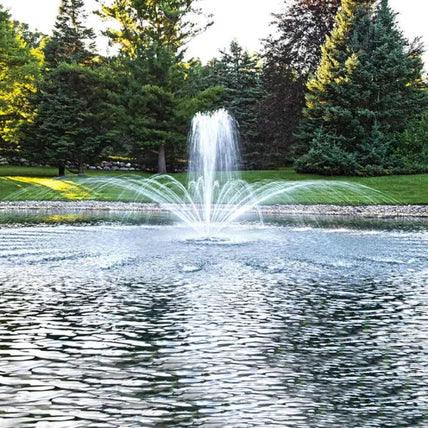
Choosing the Ideal Aeration System for Your Pond
Aeration is a crucial aspect of maintaining a healthy and thriving pond ecosystem. Proper aeration enhances water quality, increases dissolved oxygen levels, reduces algae growth, and supports various aquatic life forms. As a pond owner, selecting the right aeration system is essential for ensuring the long-term well-being of your pond. In this blog, we will explore the various types of aeration systems available, their benefits, and factors to consider when making your decision.
Understanding the Importance of Aeration
Before diving into the different aeration systems, let's discuss why aeration is vital for a pond. Aeration is the process of adding oxygen to the water, promoting a balanced ecosystem. Oxygen is crucial for the survival of fish, beneficial bacteria, and other aquatic organisms. It aids in breaking down organic matter, reducing the build-up of harmful gases, and preventing water stagnation.
Insufficient oxygen levels can lead to a myriad of issues such as fish kills, foul odors, and excessive algae blooms. By choosing the right aeration system, you can effectively combat these problems and maintain a healthy pond.
Types of Aeration Systems
Surface Aeration
Surface aeration involves agitating the water's surface to facilitate gas exchange between the air and the water. This type of aeration system typically utilizes a fountain, floating aerators, or surface propellers. Here's a closer look at each:
Fountain Aeration
Fountain aerators like the Scott Aerator DA-20 Display Aerator not only provide a visually pleasing display but also help in aerating the pond. The water ejected into the air increases oxygen absorption, while the cascading effect adds aeration as water returns to the pond surface. Fountain aerators are suitable for ponds with depths up to 8-10 feet and are excellent for small to medium-sized ponds.
Floating Aerators
Floating aerators consist of a floating platform with an electric motor that powers a propeller. These aerators agitate the water's surface and create a circular flow, enhancing oxygen levels. Floating aerators are beneficial for ponds with irregular shapes or in situations where a fountain might not be feasible.
Surface Propellers
Surface propellers are submerged just below the water's surface and churn the water, promoting aeration. They are energy-efficient and suitable for ponds with depths greater than 8-10 feet. These aerators are ideal for larger ponds and lakes.
Diffused Aeration
Diffused aeration, also known as bottom aeration, involves releasing air from the bottom of the pond through diffusers or air stones. The rising air bubbles create circulation, drawing water from the bottom and pushing it towards the surface. This process helps oxygenate the water and improve overall water quality.
Air Diffusers
Air diffusers like the Kasco Robust-Aire RA1 release small bubbles into the water column, increasing the contact area between air and water. These diffusers can be placed on the pond's bottom, providing optimal aeration for deeper ponds. The microbubbles they produce also enhance biological processes, aiding in the breakdown of organic matter.
Surface Aerators with Submerged Air Lines
These systems combine elements of both surface aeration and diffused aeration. An air compressor on the shore pumps air through submerged tubes or hoses, which release the air into the pond at various locations. This setup ensures efficient aeration for ponds of various depths and shapes.
Factors to Consider when Choosing an Aeration System
Now that we've explored the different types of aeration systems, let's delve into the essential factors to consider when deciding which system is right for your pond:
Pond Size and Depth
The size and depth of your pond play a significant role in determining the type and size of aeration system needed. Surface aeration systems like fountains and floating aerators are suitable for smaller ponds, while diffused aeration is more efficient for larger, deeper ponds.
Oxygen Requirements
The oxygen needs of your pond inhabitants, such as fish and beneficial bacteria, should guide your choice. Fish species have varying oxygen requirements, and densely populated ponds might need more intensive aeration.
Aesthetic Appeal
While the primary purpose of aeration is improving water quality, the visual aspect also matters. Fountains add an attractive touch to the pond and can be particularly appealing for decorative ponds.
Energy Efficiency
Consider the energy consumption of the aeration system. Solar-powered options are available, providing an eco-friendly solution that can save on energy costs in the long run.
Maintenance
Different systems require various levels of maintenance. Surface aeration systems generally have more exposed components that may require cleaning, while diffused aeration systems have submerged parts that need periodic checks.
Budget
Aeration systems come in a wide range of prices. Set a budget and find a system that aligns with your financial considerations while fulfilling your pond's needs.
Conclusion
Choosing the right aeration system for your pond is vital for creating a balanced and healthy aquatic environment. Consider the size of your pond, the oxygen requirements of its inhabitants, energy efficiency, and your budget when making your decision. Surface aeration with fountains or floating aerators is ideal for smaller ponds, while diffused aeration is more suitable for larger and deeper ponds.
By investing in the appropriate aeration system, you are ensuring the longevity of your pond and the well-being of its inhabitants, allowing you to enjoy a vibrant and thriving aquatic ecosystem for years to come.

